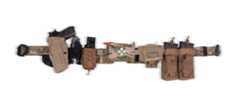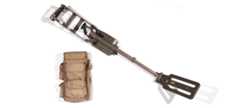
Enlisted Explosive Ordnance Disposal (EOD)
Destroy Danger
Mitigating the hazards of explosive materials and other weapons takes immense courage, precision, and skill. Explosive Ordnance Disposal (EOD) members undertake some of the Air Force's most dangerous missions in diverse and unforgiving locales worldwide. These brave Airmen work solo or in teams and employ special tools and vehicles to safely locate, identify, recover, disarm, and dispose of dangerous weapons that threaten people, property, and natural environments.
What you’ll do
- Maintain equipment, technical data and vehicles
- Protect the president, vice president and other dignitaries
- Analyze unknown munitions and explosives for intelligence agencies
- Conduct nuclear weapon response
- Detect, identify, recover, disarm and dispose of unsafe explosives and ordnance

JOIN THE FIGHTJOIN THE FIGHT BONUSES UP TO $60,000
If you’re ready to be challenged by joining an elite team of Airmen, you can receive an enlistment bonus of up to $60,000. Bonuses are earned upon completion of the EOD training pipeline and a six-year enlistment contract. Bonuses vary depending on whether you join Air Force active duty, the Air National Guard or Air Force Reserve.

Explosive Ordnance Disposal (EOD)
BUILD NERVES OF STEEL
Swipe to see the training pipeline for EOD.
01 BASIC MILITARY TRAINING (BMT)
7.5 weeks | Lackland AFB, TX
The first step to becoming an Airman happens in BMT, where trainees learn military structure, the core values of the U.S. Air Force and how to prepare both mentally and physically for life as an Airman.LEARN MORE02 EOD PRELIMINARY COURSE (EOD PRELIM)
26 days/Sheppard AFB, TX
To prove they have what it takes, Airmen must undergo intense strength and conditioning training. They’ll also receive instruction and assessment on their ability to operate under pressure while conducting explosive operations.03 NAVAL SCHOOL, EXPLOSIVE ORDNANCE DISPOSAL (NAVSCOLEOD)
143 days/Eglin AFB, FL
At this joint service schoolhouse, Airmen will train side by side with Army, Navy and Marine Corps candidates on subjects ranging from explosive tools and techniques to nuclear weapon response operations to build the skills needed to handle the most extreme situations.

EOD IN TRANSITION
DO YOU HAVE WHAT IT TAKES?
Swipe to see what is required to become an EOD technician so you can prepare before entering the pipeline.
01 PULL-UPS (2 MIN) - 6 REPS

02 SIT-UPS (2 MIN) - 40 REPS

03 PUSH-UPS (2 MIN) – 40 REPS

04 RUN 1.5 MILES IN LESS THAN 11:00

key things to considerkey things to consider REQUIREMENTS
You must meet several requirements before joining the Air Force. These concern your background, overall health and other standards set by the Air Force, Department of Defense and federal law.
You must be 17–42 years of age, a U.S. citizen and obtain a qualifying ASVAB score
High School Students may start their application as early as the end of their junior year.
Minimum score of 54 on the Predictive Success Model* (PSM).
*Score is generated from raw ASVAB scores combined with TAPAS.
- Height must be no less than 60 inches and no more than 78 inches.
- Successful completion of the EOD Initial Fitness Test (IFT) twice.
- Minimum score of 54 on Predictive Success Model (PSM).
- No record of emotional instability or treatment within the last 12 months
- Pass color vision evaluation
- Ability to recieve and maintain a "Top Secret" security clearance
- Must be at least 17, but has not reached age 42 on the date of enlistment
Tools of the trade
BOMB SUIT
When remote manipulation is not an option, the bomb suit is an EOD technician’s full-body shield and sole source of protection against an explosive threat.

LOW-PROFILE BELT
This utility belt is used for extra storage of necessary mission-essential equipment, including a magazine dump pouch, a knife, multi-tool, personal medical kit, pistol holster and extra ammunition.

LOW-PROFILE BELT
This utility belt is used for extra storage of necessary mission-essential equipment, including a magazine dump pouch, a knife, multi-tool, personal medical kit, pistol holster and extra ammunition.

MTGR - MICRO TACTICAL GROUND ROBOT
This lightweight robotic platform can maneuver in all terrains and enables EOD technicians to assess and disarm Improvised Explosive Devices (IEDs) from a safe distance.

F6A ROBOT
This state-of-the-art robot is the preferred tool for stateside operations and gives EOD technicians the enhanced ability to precisely manipulate IEDs.

Compact Metal Detector (CMD)
The compact metal detector is designed to alert EOD technicians of possible explosive threats in contingency operations.

DUAL-SENSOR DETECTOR
A dual-sensor detector enables EOD technicians to locate subterranean or otherwise obscured explosives and IEDs.

LOCK-PICKING KIT
In deployed locations, EOD technicians utilize advanced lock-picking kits and expert training to breach facilities and carry out their missions silently and efficiently.

MULTI-TOOL AND KNIFE
The multi-tool and knife are essential in every EOD technician’s arsenal and are the ideal pair for the technically challenging task of disarming, detonating and disposing of explosives.

REMOTE FIRING DEVICE
Remote firing devices enable EOD technicians to maintain a safe distance from large-scale detonations and provide critical control of demolition operations for both stateside and deployed operations.

DIGITAL X-RAY SYSTEM
EOD technicians use radiographic technology during improvised explosive device (IED) operations in order to decipher a device’s internal workings and determine the best course of action to disarm it.

Swipe up for more